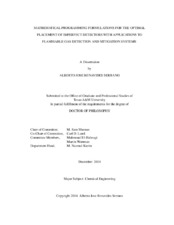| dc.description.abstract | The placement of detectors in mitigation systems is a difficult problem usually addressed in the industry via qualitative and semiquantative approaches. Simplifications are used to circumvent difficulties regarding problem size, parameter uncertainty, and lack of information concerning leak development. Given recent improvement of consequence modeling tools, the use of a stochastic Mixed-Integer Linear Programming (MILP) formulation (SP) was previously proposed to quantitatively approach this problem. This formulation minimizes the expected damage over a large set of gas leak scenarios while assuming perfect detectors. In reality gas detectors are prone to false positives and false negatives. Two solutions are usually implemented in the process industries. First, additional confirmation from several detectors (i.e., voting) is required before emergency actions are triggered in order to avoid false positives. Second, in order to avoid false negatives, the unavailability of the detectors is considered in the placement strategy. Unavailability corresponds to the probability that the detector will not be able to perform its intended function when required.
In the first part of this dissertation, two problem formulations were developed and validated to address the issue of imperfect detectors: minimization of expected damage considering unavailability (SP-U) and minimization of the expected damage considering unavailability and voting (SP-UV). SP-U and SP-UV placement results were compared with those obtained assuming perfect detectors. Results demonstrate that explicit consideration of unavailability and voting effects alters the final detector placement. Quantitative risk can be significantly higher if we neglect these issues when solving for the optimal placement. Furthermore, SP-UV placement results were compared with those of four existing approaches for gas detector placement using three different performance metrics in accordance to the objectives of gas detection systems. Results provide further evidence on the effectiveness of the use of dispersion simulations, and mathematical programming, to supplement the gas detector placement problem.
Formulation SP-U assumes a uniform unavailability across all detector types and locations. In the second part of this work, this assumption is relaxed via formulation SPqt, which considers non-uniform dynamic detector unavailabilities. Relaxing this assumption results in a Mixed-Integer NonLinear Programming (MINLP) formulation. SPqt, being an extension of SP-U, explicitly considers di↵erent backup detection levels, allowing an approximation where the maximum degree of the nonlinear products considered can be determined by the modeler. The effect of reducing the number of detection levels was analyzed. For the problem, results shown that two detection levels are sufficient to find objective values within 1% of the optimal solution. Considering two detection levels reduces the MINLP formulation to a zero-one quadratic formulation (SPqt-Q). A solution quality comparison between SPqt-Q and approximate solution strategies previously proposed in the literature demonstrates its suitability to obtain approximate answers for the general nonlinear problem. Two exact linear reformulation strategies (SPqt-L1 and SPqt-L2) were proposed for SPqt-Q and validated from the computationally efficiency perspective.
All the results presented were obtained by using four real data sets provided by Gex-Con. The data corresponds to FLACS CFD dispersion simulations including the full geometric features of an offshore facility and capturing the uncertainty in the leak characteristics. Additionally, real unavailability values were obtained from industry gas detector reliability databases. The work presented here constitutes a step forward toward the achievement of a realistic detector placement formulation that includes current industrial practice for these important safety systems. | en |


